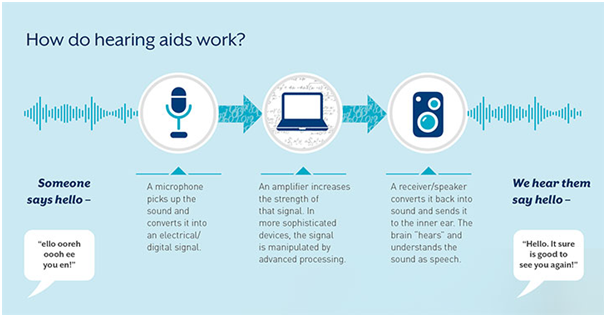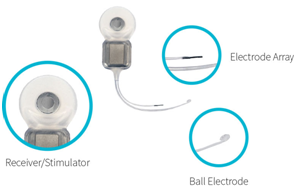
Our ear consists of 3 major sections
The outer ear consists of the outside part(the pinna) and the ear canal. The outer ear picks up sound waves from the surroundings and leads them through the ear canal into the middle ear.
The middle ear consists of the eardrum and three bones called ossicles. These individual bones are called the malleus, incus, and stapes. When sound enters the middle ear, it hits the eardrum and makes it vibrate. The middle ear transfers sound waves into mechanical pressure waves that are then transferred to the fluids of the inner ear.
The inner ear contains the cochlea and hearing nerve, as well as semicircular canals that help with balance. Vibrations from the middle ear flow through the fluid in the inner ear and cause hair cells in the cochlea to move. The hair cells change this movement into electric impulses that travel to the hearing nerve (auditory nerve), which connects to the brain.
This entire process happens in a fraction of a second.
Hearing loss, also known as hearing impairment, is a partial or total inability to hear. A deaf person has little to no hearing. Hearing loss may occur in one or both ears. Hearing loss can be temporary or permanent.
Hearing loss may be caused by a number of factors, including genetics, aging, exposure to loud sounds, some infections, birth complications, trauma to the ear, and certain medications or toxins. Hearing loss is diagnosed when hearing tests find that a person is unable to hear in at least one ear. Testing for poor hearing is recommended for all newborns.
In children, hearing problems can affect the ability to learn spoken language and in adults, it can create difficulties with social interaction and at work. In some people, particularly older people, hearing loss can result in loneliness.
When you visit your audiologist for a hearing test, you may be told that you have a mild or severe or any other degree of hearing loss. It is based on how loud sounds need to be, for you to hear them. The term dB HL describes your hearing loss in decibels.
| Degree of hearing loss | Hearing loss range (dB HL) |
| Normal | -10 to 15 |
| Slight | 16 to 25 |
| Mild | 26 to 40 |
| Moderate | 41 to 55 |
| Moderately Severe | 56 to 70 |
| Severe | 71 to 90 |
| Profound | 91+ |
Source: Clark, J. G. (1981). Uses and abuses of hearing loss classification. Asha, 23, 493–500.
As per WHO data as of 20th March 2019, Over 5% of the world’s population – or 466 million people – has disabling hearing loss (432 million adults and 34 million children). It is estimated that by 2050 over 900 million people – or one in every ten people – will have disabling hearing loss.
Disabling hearing loss refers to hearing loss greater than 40 decibels (dB) in the better hearing ear in adults and a hearing loss greater than 30 dB in the better hearing ear in children. The majority of people with disabling hearing loss live in low- and middle-income countries.
Approximately one-third of people over 65 years of age are affected by disabling hearing loss. The prevalence in this age group is greatest in South Asia, Asia Pacific, and sub-Saharan Africa.
'Hard of hearing' refers to people with hearing loss ranging from mild to severe. People who are hard of hearing usually communicate through spoken language and can benefit from hearing aids, cochlear implants, and other assistive devices as well as captioning. People with more significant hearing losses may benefit from cochlear implants.
Functional impact
One of the main impacts of hearing loss is on the individual’s ability to communicate with others. Spoken language development is often delayed in children with unaddressed hearing loss.
Unaddressed hearing loss and ear diseases such as otitis media can have a significantly adverse effect on the academic performance of children. They often have increased rates of grade failure and a greater need for education assistance. Access to suitable accommodations is important for optimal learning experiences but are not always available.
The social and emotional impact
Exclusion from communication can have a significant impact on everyday life, causing feelings of loneliness, isolation, and frustration, particularly among older people with hearing loss.
Economic impact
WHO estimates that unaddressed hearing loss poses an annual global cost of US$ 750 billion. This includes health sector costs (excluding the cost of hearing devices), costs of educational support, loss of productivity, and societal costs.
In developing countries, children with hearing loss and deafness rarely receive any schooling. Adults with hearing loss also have a much higher unemployment rate. Among those who are employed, a higher percentage of people with hearing loss are in the lower grades of employment compared with the general workforce.
Improving access to education and vocational rehabilitation services, and raising awareness, especially among employers about the needs of people with hearing loss, will decrease unemployment rates for people with hearing loss.
Power supply (batteries)
Microphones and receivers convert energy from one form to another. The microphone gathers sound and converts it into an electrical signal. The receiver gathers electrical signals from the amplifier and converts them back into acoustic energy (sound).
Located between the microphone and receiver, the amplifier increases the amplitude of the signal supplied by the microphone before transmitting it to the receiver, which sends it to your inner ear.

This process occurs so rapidly that the listener will hear sounds without any noticeable delay.


BAHA is a surgically implanted device designed to help people with hearing loss. The majority of conventional hearing aids transmit sound through the medium of air conduction. BAHA stimulates the cochlea by transmitting the sound waves through the bones in our skull, or bone conduction, thereby bypassing the outer and middle ear. Once the cochlea receives the sound signals, the information is converted into neural signals and transferred to the brain, where it is perceived as sound. thereby bypassing the outer and middle ear.
